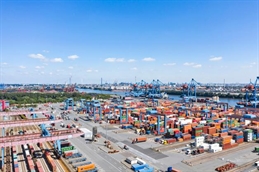
The Port of Hamburg recorded lower first-quarter seaborne cargo throughput as repercussions of the coronavirus crisis started to manifest.
Germany's largest port said seaborne cargo throughput dropped 7.9% in the first quarter of this year at 31.9 million tons as container handling reached 2.2 million TEUs, also down by 6.6%.
The port noted, however, that throughput on seaport-hinterland services was less seriously hit by the downturn and container hinterland transport services remains "comparatively stable." The drop in demand for transhipment handling was more obvious, it added.
Port of Hamburg said the slackening of import and export flows apparent in Germany’s largest universal port can be explained by the interruption to transport and supply chains caused by the impact of the corona crisis.
“The partial shutdown of the Chinese economy, resulting in blank sailings in shipping, has led to lower cargo handling in Hamburg as well,” said Axel Mattern, joint CEO of Port of Hamburg marketing.
Mattern pointed out that the port with its high-performance cargo handling terminals and inland transport services remains fully operational.
In the container handling segment, in the first quarter of 2020 a total of 2.2 million TEU – 20-ft standard containers – were loaded or discharged across the quay walls of the Port of Hamburg, representing a 6.6% downturn on the previous year.
Muted volumes from China
Among the Port of Hamburg’s most important partner countries by volume on seaborne container traffic, first-quarter trends varied a great deal, it said.
At 579,400 TEU, the total number of containers handled during the first quarter in the Port of Hamburg for China, its most important trading partner, was 14.6% lower. “The downturn in seaborne cargo throughput with China is explicable in connection with the repercussions of the corona crisis,” said Mattern.
The US, ranking second as Hamburg’s container partners, still reporting a 20.7% growth for the quarter, as Singapore, it's next biggest trading partner also grew 10.5%.
Improved rail utilization
In the Port of Hamburg, the transhipment sector, or container throughput between ocean-going and feeder vessels, was also affected by the coronavirus crisis with a decline of 10.8% to 772,000 TEUs.
Seaport-hinterland container services by rail, truck and inland waterway craft proved more stable in the first quarter, the volume being just 4% lower at 1.4 million TEUs.
"Of such significance for the Port of Hamburg, rail borne freight transport, down 4.3% at 11.9 million tons, or 4.6% at 663,000 TEU, on the first quarter of 2019, was still at a considerably higher level than the 612,000 TEU for I/2018," it said.
“In recent weeks the Port of Hamburg’s superb hinterland connection has played a major part in ensuring that even in difficult times its effectiveness has remained unimpaired,” said Jens Meier, CEO of HPA.
“Despite temporarily lower container volumes caused by the corona crisis, in the first quarter, the Port Railway was able to report stable utilization and indeed even to improve on the 2018 level. That was by no means to be taken for granted, but is the result of systematically boosting efficiency and continuously expanding the Hamburg Port Railway.”
The first-quarter throughput of bulk cargoes was 11.9% lower at 9.4 million tons. Exports grew by 11.9% at 2.7 million tons.
For the next few months, Axel Mattern assumes that the Port of Hamburg must initially adapt to a continuation of blank sailings and falling total throughput.
“From June, it is entirely possible that with a gradual pick-up in the economy in China and Europe, we shall be seeing an increase in sailings and rising volumes on port throughput and seaport-hinterland services,” Mattern said.




